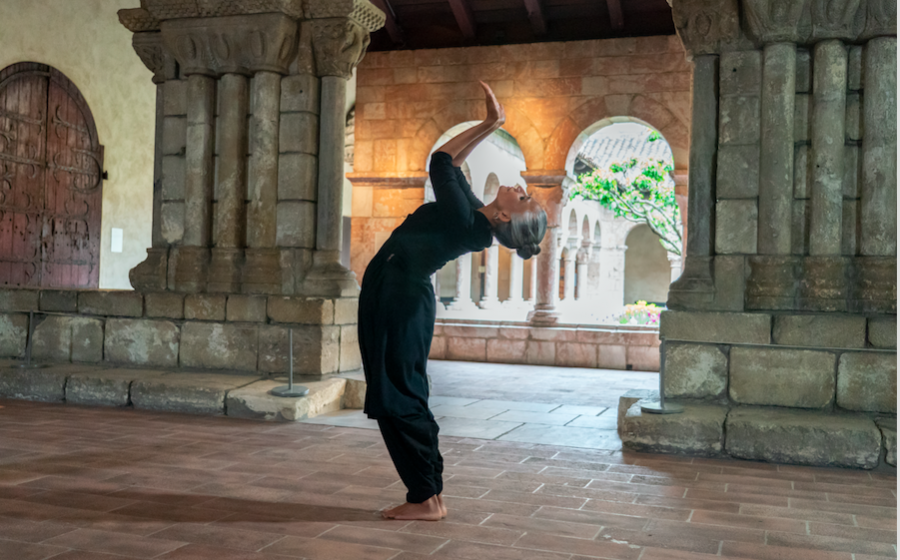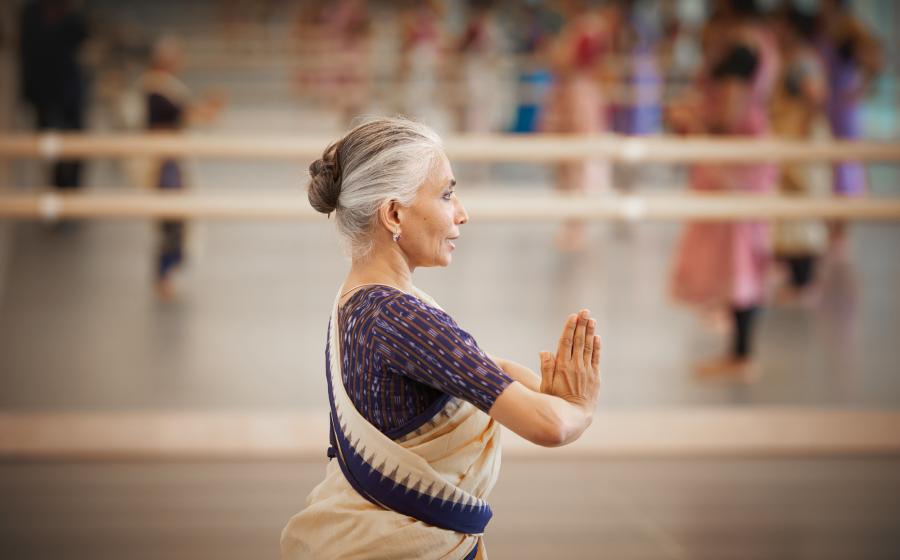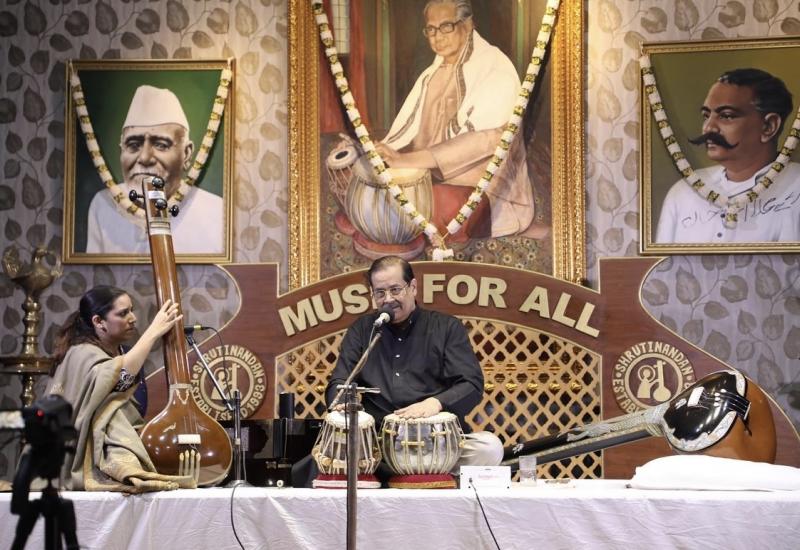Bijayini Satpathy – Odissi Master in her Prime
Bijayani Satpathy has the reputation of being the most revered odissi dancer in the world. She is held in high esteem by the New York dance establishment (the home of modern dance), with plaudits from such major figures as contemporary choreographer Mark Morris and ballet star Mikhail Baryshnikov. Her 2021 evening-length solo work ABHIPSAA – a Seeking – achieved critical success when it premièred in December 2021 at Duke Performances. Her dramatic exploration and reshaping of an ancient tradition has propelled the artist to the forefront of the art.
We begin this profile with a look at some of the films that have been created from her year–long residency (2021-22) at the Metropolitan Museum in New York, Bijayini Satpathy in the Galleries. Their Director of Live Arts, Limor Tomer invited her to explore the spaces of the museum and find inspirations with which to create and find her own unique voice.
There are five films – four between thirteen and seventeen minutes in length and the last, which amalgamates ideas and sections from each, fifty minutes (links below). The dancer ‘engages with each site’s architecture as well as with its ancestry, stories, legends and aesthetics’. The four galleries selected are the Islamic, the Cloisters, the Chinese courtyard garden and the Gallery of Modern and Contemporary Art. Working in collaboration with a composer/musician, costume and lighting designer, dramaturg and camera and video, the scope of the canvas for the dancer expands to employ all these elements to enhance the creation. I am selecting two of the four to comment on as I feel these represent the essence of the dancer’s vision and accomplishment.
Prayer is set in the Cloisters Museum. The Cloisters, built in 1938 in northern Manhattan, derives its name from the portions of five mediaeval cloisters incorporated into a modern museum structure. The architecture of the space, with three layers of columns and arches opening onto an inner courtyard, is the perfect setting to echo the lines of dance, and to frame the dancer. The theme is also completely in harmony both with the dance style (born in temples and out of the movements of ritual worship) and the place setting of cloisters, which evoke spaces of contemplation and worship.
In the opening ‘namaskar’ to the space, the dancer holds a perfect vertical axis which is also the builder’s ‘plumb line’. A number of movements emphasise the verticality. The openness and breadth is established by the ‘chauka’, the ninety-degree turnout of the knees and the arms held at right angles. The four cardinal directions are honoured. The awe that the space evokes is ever present in the dancer’s expression but is judicious and contained. The dancer maintains an equipoise and inner stillness which powers her dance. The superb sound score by composer Bindumalini Narayanaswami incorporates bells and gongs, breath and voice, which give a rich and imaginative accompaniment. The third element, the camera, engages the viewer by changing angles and perspective. A particularly striking visual is the backlit exterior with the dancer in silhouette.
Satpathy’s control and flexibility are never in question – the back bends and front lunges for instance give dynamism and contrast to the inner stillness. Playing with the form such as the splayed fingers on the shoulders, each creating its own ‘arch’ is a beautiful moment. Satpathy is certainly bringing all her intuition and imagination to ‘play’ with her form. All the elements from dress and accessories – a simple black kameez and trousers, the long black bindi on forehead (further heightening verticality), to the music and sound score, the glorious setting and sympathetic camera work combine to create a piece of great depth and beauty.
Antaranga (‘intimate’), made for the Gallery of Modern and Contemporary Art in the Metropolitan Museum, in contrast is the most abstract of the works and also the most mysterious and haunting. The minimalist score of Bindumalini Narayanaswami matches the mood perfectly. Set to ‘Fragment 31’ by the poet Sappho, it is beautifully rendered by Niti Bagchi and expresses the poet’s intense passion towards a woman as well as the pain and jealousy of seeing the woman seated with her male consort. The interpretation by Satpathy is intense but in a very different way from the abhinaya that we associate with classical dance. There is no obvious ‘emoting’. Yet there is conflict and struggle, there is tenderness and sensuality. Watching the piece, the need for narrative falls away. We are swept along on an emotional tide from one moment to the next.
The mind creates its own story – it could be the struggle to break out of convention heralding ‘modern’ art for instance. The background of vivid coloured drapes (Sam Gilliam) provides a vibrant setting to the dancer’s austere figure in black and white. Satpathy uses a wide open stance (more mandala than chauka), with charis from the Natyasashtra. Sequences on the floor and at the knee level dominate: fluid yet intricate and worked, there is tension and release, propulsion towards and sudden holding back.
The casual expressiveness of head in hands at the opening and the close, the running hand along the floor suggesting pleasure, give the piece a unique individuality. There are hesitations and moments held: the camera zooms in on the back of the head bent over her outstretched leg filling the frame; or the solitary figure, tiny in the scale of the huge gallery, gazing at the artwork. She is suggesting, ‘Have I seen a vision?’ We are moved by it without fully knowing why. It is said that the best art is that which stirs our subconscious and releases memories and emotions we never knew we had.
Close watching of Bijayni Satpathy’s films on the Met is a deeply satisfying experience as these have layers of meaning and significance. The dancer has surely answered the question she posed to herself, ’Am I a choreographer with a unique voice?’
It is not that Satpathy’s dance needs the validation of her Western counterparts, but getting rave reviews in the New York Times (starting with Jennifer Dunning’s review in 1996 of the Nrityagram Ensemble in which it must be pointed out Surupa Sen is the dancer singled out) helps to pull in dance audiences; and the reality is that the mainstream holds the power. New York therefore has been instrumental in catapulting her to this hallowed status. However, she has put in the work.
Thirteen years of training from the age of seven to twenty; then twenty-five years of round-the-clock studio time in Nrityagram have prepared her body to achieve the sinuous bends, the extensions, the fast-paced coverage of space that give dynamism and excitement to performance. Technique combines with intelligence, emotional sensitivity and an inner fire to give her the aura of smouldering beauty.
I met Satpathy at Kingston University where I was privileged to observe her workshop, hosted by Elena Catalano, director of Bhumi Dance Academy, who also lectures in their Dance Department. After the teaching session, we found a quiet sitting area in the airy new studio building to talk. Bijayini gave us her full attention and her detailed responses were thoughtful and considered.
Childhood
Discovering dance at her Ashram School in Bhubaneshwar
Satpathy attended the Sri Aurobindo School in Bhubaneshwar where dance and music were an integral part of the school curriculum. She recalled that she frequently found herself in a room set aside for quiet time. She would gaze at reflections of herself striking different poses in the glass of framed images of Sri Aurobindo and The Mother.
Twice a week Durga Charan Ranbir (subsequently the famous guru of the Deba Prasad style) came to teach the children. The young Bijayini must have shown promise as it was suggested that she should attend a regular class. The Orissa Dance Academy had been opened by Gangadhar Pradhan, and her father was told that ‘they give a good foundation’.
Students of the Bhubaneshwar Music College, some of whom were former gotipua performers (child acrobatic performers until puberty), were helped by the founder to gain Dance degrees to become teachers. The artist was full of praise for the young students who attended college during the day and became teachers in the evening.
Satpathy’s father faithfully made the journey to accompany his daughter to dance class twice a week after his long and tiring day at the bank. ‘I was the first one to class and the last one out’. When I asked her who she looked up to as a performer, she mentioned admiring Aruna Mohanty and Nandita Behera.
Aged twenty and a college student learning Sanskrit and Education Studies, Satpathy felt something was lacking in her dance experience that she could not put her finger on. ‘I had no picture of a life in dance’, she recalls, ‘I thought that unless you were Sanjukta Panigrahi with a husband as a vocalist, you couldn’t be a full-time dancer’.
She might have given up, but at that point, in 1993, Protima Gauri came to Orissa to audition dancers to join the Nrityagram Ensemble’s forthcoming tour. Satpathy was selected and that confirmed the path she was to take. Against parental opposition she left home to join Nrityagram. The prospect of dancing twenty-four hours a day was thrilling.
Joining Nrityagram- home for the next 25 years
Nrityagram (‘Dance Village’) was set up in 1990 near Bangalore by the larger-than-life Protima Gauri, former model and Bombay socialite who had fallen in love with odissi dance. The first teacher of the form Shankar Behera (from the same cohort of dance degree graduates as Gangadhar Pradhan), had arrived in Bombay in 1971 and was beginning to put odissi on the map. After initial sessions Protima Bedi (as she then was) sought out Guru Kelucharan Mahapatra and started to learn from him. Her dedication to the art took Protima Gauri on a journey that would lead to the legacy of which the world is beneficiary.
The vision of a Gurukul, a teaching institution where the teachers and dancers lived together and passed on their art form holistically was noble, but too many practical difficulties stood in the way. Of the seven styles of classical dance and two martial arts that the founder wanted to represent, only odissi, mohiniattam and kathak commenced. The sheer distance from their home bases to Bangalore was an impediment to attracting teachers. Guruji left after three years (one can imagine him being homesick for Orissa). In 1997 Protima Gauri handed the running of Nrityagram to Lynne Fernandez, who was Technical Director at the time. The following year, Protima Gauri met an untimely death in a landslide in the Himalayas whilst on pilgrimage (she was only 49).
When Satpathy arrived at Nrityagram in 1993, living in a community of dancers with only the one goal of practising dance afforded something very rare – the time to de-construct the dance form to understand its constituent parts and to put these together in new and myriad combinations. Among the teachers Protima Gauri invited to conduct workshops were yoga and martial arts practitioners. The dancers were working on body, breath, extensions and understanding the relationship between body and space through the study of other techniques.
Satpathy said she became obsessed with understanding the body of a dancer. She had an insatiable curiosity for bio-dynamics – from where the movement originated, what muscle groups were needed and how these should be strengthened. This informed the choreography of Surupa Sen (Artistic Director) and the style emerged from that process of constantly working with the body. The twenty basic movements that had existed in odissi training were not enough, and the choreography was researched, to explore what were the myriad in-between movements not covered in the twenty. This led to the development of 200 movements in the basic training.
From 1998 Sen and Satpathy worked together and received their first batch of students. Sen concentrated on choreographic development: how to give three-dimensionality to a form that was predominantly frontal and symmetrical. She brought in the use of the back, diagonals, spaces on the periphery. At the same time, she incorporated elements that had been lacking in the style: the coverage of space, leaps and the use of levels. While Sen led in the choreographic experimentation Satpathy had to work out the steps towards body preparedness. This was a combination made in heaven and gave the cutting edge to the Nrityagram Ensemble and their unparalleled position in the dance world. Their sheer technical qualities shone wherever they performed. The Nrityagram Ensemble toured annually throughout India and abroad, particularly in the States.
Enter Angel Sponsor
Prior to the era of state subsidy, the arts have always relied upon wealthy patrons – whether the Rajahs and Nawabs in India or the mercantile houses and courts of Renaissance Italy. In India there has been little in the government coffers, especially in the 1980s and ‘90s, to invest into art. Protima Gauri understood that and from the outset had planned a resort next to Nrityagram which would attract visitors and hopefully potential sponsors. The Village school had a tradition of open rehearsals so that visitors could observe the dancers at work.
Amongst the many that came was a young couple known to the Nrityagram administration as ‘Jennifer and Jonathan’; it transpired later that the latter was the son of financier George Soros. The two spent hours watching the dancers at class. At the end of their stay, they asked if the dancers would like to perform in New York. It was 1996, and the performance at the Danny Kaye Theatre in Hunter University was to become a turning point for the Company.
Jennifer Dunning, dance writer and critic for the New York Times, declared, ‘In one of the most luminous dance events of the year, the Nrityagram Dance Ensemble of India made its New York debut’. And again ‘In addition to impressive technical expertise, they performed with a burnished grace, a selfless concentration and a depth that reflected their intensive training in dance, music, literature, language and philosophy.’ This was the breakthrough performance for Nrityagram that earned them repeat tours to New York on an annual basis.
Going Solo
A new phase opened for Satpathy when she took the decision to go solo in 2018. After twenty-five years of living in a dance community, to take oneself into a space of one’s own (with partner and several cats and dogs) was a huge move. This coincided a year later with the Covid lockdown. It was a scary time but also provided an opportunity to do something new. Then the offer came that was the defining moment for the artist. The residency at the New York Met Live Arts has catapulted the artist into new territory and as the films will demonstrate the Satpathy has relished the challenge.
Bijayini Satpathy’s brave step to go solo has reaped rich rewards with much more to come.
You can watch all five films on You-Tube
Bijayini Satpathy in the Galleries: Antaranga (Modern and Contemporary Art) | MetLiveArts
Bijayini Satpathy in the Galleries: Taru (Islamic Art) | MetLiveArts
Bijayini Satpathy in the Galleries: Naino (Astor Chinese Garden Court)
Bijayini Satpathy in the Galleries: The Prayer | MetLiveArts
Bijayini Satpathy in the Galleries: Doha | MetLiveArts





















